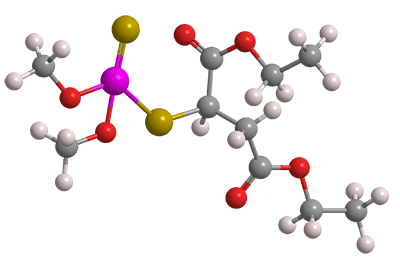What molecule am I?


Malathion1 is an organophosphate insecticide that was developed in the early 1950s by Jack T. Cassaday and co-workers at American Cyanamid (Stamford, CT). It and other dithiophosphate–maleate esters were claimed as compositions of matter in US Patent 2,578, 652 (1951). It acts as an acetylcholinesterase inhibitor to poison insects.
A liquid with a skunk- or garlic-like odor, malathion is still on the market today for commercial and domestic use despite findings that it and similar pesticides are probable carcinogens. It is considerably safer to use than the similar organophosphate parathion2, which has been banned or restricted worldwide.
In 2017, the US Environmental Protection Agency found that malathion would adversely affect almost all endangered species and their habitats. In 2021, based on EPA’s findings, the US Fish and Wildlife Service determined that the insecticide is likely to harm 78 species and 23 critical habitats. But during this period, EPA, Fish and Wildlife, and pesticide manufacturers collaborated to develop mitigation measures for malathion.
This past March, Fish and Wildlife concluded that, if the mitigation measures are put in place, threatened and endangered species would not be harmed by malathion applications. EPA expects to approve new malathion labels by late 2023. Environmental advocacy groups, however, strongly objected to Fish and Wildlife’s decision and would like stronger controls to be enacted. One advocate said that the agency ignored “the best available science” and chose “to rely on unenforceable promises of good behavior by the pesticide makers rather than real on-the-ground conservation measures.”
1. SciFinder: butanedioic acid, 2-[(dimethoxyphosphinothioyl)thio]-, 1,4-diethyl ester.
2. CAS Reg. No. 56-38-2.
Malathion acid hazard information
| Hazard class* | GHS code and hazard statement | |
|---|---|---|
| Acute toxicity, oral, category 4 | H302—Harmful if swallowed | |
| Skin sensitization, category 1 | H317—May cause an allergic skin reaction | |
| Carcinogenicity, category 1B | H350—May cause cancer | |
| Short-term (acute) aquatic hazard, category 1 | H400—Very toxic to aquatic life | |
| Long-term (chronic) aquatic hazard, category 1 | H410—Very toxic to aquatic life with long-lasting effects | |
*Globally Harmonized System of Classification and Labeling of Chemicals. Explanation of pictograms.
Malathion fast facts
| CAS Reg. No. | 121-75-5 |
| Empirical formula | C10H19O6PS2 |
| Molar mass | 330.36 g/mol |
| Appearance | Yellow to brown liquida |
| Melting point | 3 °C |
| Boiling Point | 156–157 °C (0.7 Torr) |
| Water solubility | 143 mg/L |
a. Colorless when pure.
MOTW updates
Withaferin A1 (TCA) was the Molecule of the Week for December 19, 2016 . A steroidal lactone, it is found in the Indian plant Withania somnifera and has many potential pharmaceutical uses. Earlier this month, Anindita Chakrabarty, Goutam Chowdhury, and colleagues in India and the United States reported that withaferin A and withanone2, another W. somnifera steroid derivative, are covalent inhibitors of the main protease of SARS-CoV-2, the virus responsible for COVID-19.
Δ9-Tetrahydrocannabinol3 (THC) was the Molecule of the Week for January 24, 2011. It is well known as the dominant psychoactive agent in marijuana; but now it has another, surprising, application. This month, Evan R. Darzi and coauthors at ElectraTect (Phoenix) and the University of California, Los Angeles, described a current-producing fuel cell that relies on the oxidation of THC . The researchers believe that this device could be used to develop a marijuana breathalyzer.
1. CAS Reg. No. 5119-48-2.
2. CAS Reg. No. 27570-38-3.
3. CAS Reg. No. 1972-08-3.

Learn more about this molecule from CAS, the most authoritative and comprehensive source for chemical information.
Molecule of the Week needs your suggestions!
If your favorite molecule is not in our archive, please send us a message. The molecule can be notable for its current or historical importance or for any quirky reason. Thank you!
Stay Ahead of the Chemistry Curve
Learn how ACS can help you stay ahead in the world of chemistry.

